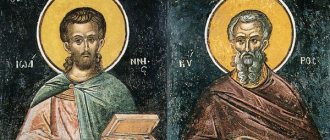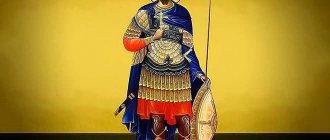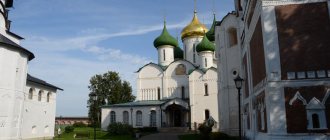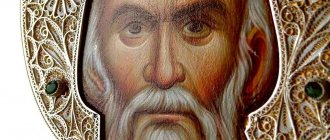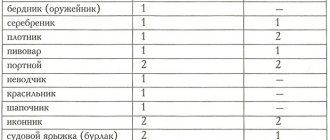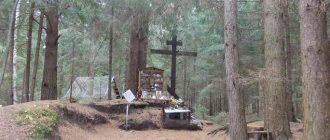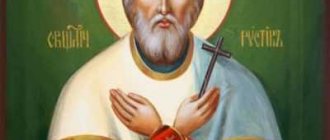Life of Saint Basilisk of Koman
Not much information has been preserved about the life of Saint Basilisk. Basic information about the Koman martyr and his sufferings is described in the Synaxarium of the Orthodox Church of Constantinople.
Origin
The exact date of birth of Saint Basilisk is unknown. It is only known that he lived at the end of the 3rd century. The family of the future martyr lived near Amasya (the territory of modern Turkey) in the village of Khumialon (Kumialon), located at a distance of 9 km from the Pontic Koman. Basilisk's parents were pious Christians, and his uncle, Theodore Tyrone, suffered martyrdom.
Serving God
Basilisk, like his brothers, Cleonicus and Eutropius, served in the Roman army. The young warriors preached the gospel among the pagans, for which they endured much suffering and were imprisoned.
After the execution, Cleonicus and Eutropius Basiliscus were transferred to a Comanian prison. St. Basilisk constantly prayed, asking the Lord not to leave him, speaking of his readiness to accept the crown of martyrdom. One day the Almighty appeared to the righteous man, promising to be with him to the end in order to ease his torment. The Lord commanded the martyr to go home to say goodbye to his family.
The next day, the martyr persuaded the guards to let him go home for 4 days to say goodbye to his mother. But, since the arrival of the new hegemon Agrippa was expected, the guards were afraid that they would be punished. Later, heeding the saint’s persuasion, several warriors went with him to his village.
At home, Basilisk told his mother and brothers about his impending death, calling on his family to remain steadfast and devoted to the Christian faith. Having received his mother's blessing, the martyr set off on his return journey.
At this time, the new ruler Agrippa arrived in Coman and became very angry when he did not find Basilisk in prison. Soldiers were sent for the martyr, led by the ruler's assistant (magistrian), who was particularly cruel. By order of the magistrate, the returning righteous man was shackled in chains, and heavy copper boots were pulled onto his feet, with nails driven into the soles.
Having reached the village of Dakozar, the guards decided to rest. The Magistrians and the soldiers went to feast at the house of the widow of Trojan, who professed paganism. The basilisk was tied to a dry tree growing near the house.
A crowd of people gathered near the saint, who was earnestly praying to the Lord. Suddenly the heavy boots fell off the martyr’s feet, the dried-out tree began to burst into greenery, covering the saint with its thick branches from the hot sun. And on the ground, where drops of blood flowed from the saint, a spring began to flow.
Seeing such miracles, many people believed in Christ. People flocked to the miracle worker asking for healing. The saint did not refuse anyone, healing everyone with his touches and words. The guards accompanying the Basilisk of Komansky, having believed in the Almighty, led him further without shackles.
Martyrdom and death
When the martyr finally appeared before the ruler Agrippa, he ordered the saint to be taken to the temple with statues of the pagan gods - Apollo and Artemis. The ruler wanted to get the righteous man to make a sacrifice to the pagan gods. After Basilisk’s refusal, Agrippa asked why he did not want to fulfill the will of the emperor. To this the saint replied that he always performed sacrifices, bringing praise and repentance to God. Delighted by the words of the saint, the emperor asked him to offer a sacrifice, saying that it did not matter to him which god the righteous person brought the sacrifice to.
The saint, raising his hands to heaven, began to pray to the Lord, asking him to destroy the insensitive idols, so that everyone around would believe in one, omnipotent God. Before the Basilisk had time to finish his prayer, the earth shook, shook, and the stone idols fell to the ground, breaking into pieces. Agrippa and the people who were with him left the temple in fear.
Only St. The basilisk continued to sing a hymn of praise to the Lord. Stunned, Agrippa ordered the soldiers to take the righteous man out of the temple. Grinding his teeth in impotent anger, the ruler asked the saint why he destroyed the statues of the gods with his witchcraft. To which Vasilik replied that the One who has the power to crush the pagan gods can also burn the temple. Before he had time to utter these words, the heavens opened up and fiery rain fell from above, burning the temple of the pagans.
The angry ruler ordered the saint to be executed by cutting off his head. The guards took the righteous man outside Coman. The sad procession was accompanied by many people. Having reached the area called Diascor, the executioner cut off the St. Basilisk of Komansky head.
Miracle
So, who is Saint Basilisk? It is known that the martyrs Cleonikos, Basiliscus and Eutropius were born in the city of Amasya. They were presented before the ruler of the city, Asklepiodotus, for their Orthodoxy, and then severely beaten. But they had a vision of Saint Tyrone Theodore and the Lord. Therefore, they were immediately cured of all their wounds.
Many pagans were surprised by this miracle and turned to Christ, for which they were beheaded. Asclepiodotus saw that he could not force the saints to convert to paganism, so he decided to change the strategy: first he separated them, and then tried to persuade and convince them with promises and flattery to abandon the Christian faith.
His poor attempt failed. Righteous Kleonikos laughed at the ruler, but did not agree to the bribe.
Veneration of the martyr in Orthodoxy
After the execution of Basilisk, several righteous Christians, bribing the executioners, took the remains of the martyr, burying him secretly. After some time, one of the pious residents of Coman, Marinos, erected a temple on the site of the martyrdom of the saint, transferring there the incorruptible relics of Basilisk.
Later, several attempts were made to move the sacred remains to another place, but each time a pillar of fire rose from the grave. Saint Basilisk was against the transfer of his remains, wanting to remain in Comana.
In 2002, a chapel was built on the site of an ancient temple that had suffered destruction. Next to it there is a healing spring, the waters of which relieve people from many ailments.
Thousands of people come to the martyr’s grave every year to venerate the miracle worker. The Orthodox Church celebrates the day of remembrance of the Koman martyr on May 22 according to the Julian calendar (June 4 according to the new calendar). On this day, festive services are held to glorify the miracle worker.
Data
Who are the saints of the One Church? These are the people who were canonized (that is, glorified) by the Christian Unity Church before the Great Schism (1054). They are revered in both Catholic and Orthodox churches.
So, you already know that all the actions described in the article took place in the 3rd-4th century. The basilisk was born in the city of Amasya, in Cappadocia. He reposed in 308, in Comana.
The basilisk is venerated as a martyr in both Catholic and Orthodox churches. Basilisk Memorial Day:
- March 3, May 22 – for Catholics;
- March 3 (16), May 22 (June 4) - for the Orthodox.
What do they ask the saint for?
The martyr Basilisk helps people many centuries after his death. Many believers turn to the Koman righteous man, asking:
- heal physical and mental illnesses;
- strengthen faith;
- provide spiritual assistance;
- give strength to overcome troubles.
Before his martyrdom, Basilisk was a warrior. Therefore, military personnel and law enforcement officers enjoy special protection from the saint.
Church
The church in the name of the martyr Basiliscus was built by the citizen Comana Marin. It was he who transferred the holy relics to this church. What are Komans? This place is located high in the mountains of Transcaucasia, in Abkhazia. There is a monastery there, near which the chapel of St. Basilisk is located. The history of the spiritual life of this passion-bearer is as tragic as that of most of the first Christians.
The chapel of the martyr Basilisk is always open to the wanderer. Before entering it, you need to take off your shoes and cross yourself. The chapel is clean and gracious. Here, after a long journey through the hot sun, a slight coolness envelops tired people. Knowing about human physical infirmities, the monks always leave glasses and tanks of water in the chapel.
It is also known that the righteous John Chrysostom (November 13), before his death in Comana, the martyr Basilisk appeared in a dream and said: “Tomorrow we will be together.” And in these mountains a little higher there is a place where the head of the Baptist John was preserved for more than a century.
Prayer book
You can pray to Saint Basilisk not only near the martyr’s grave. Church shops sell icons of the righteous. Having acquired the holy image, you can ask the Basilisk for help at home, reading prayer requests - kontakion and troparion. These sacred texts are very short and are not difficult to memorize.
Kontakion
You appeared strong and courageous in the feat of martyrdom and amazing in miracles. By openly confessing the name of Christ, you put your tormentors to shame. Therefore we honor you, Basilisk, constantly exclaiming: “Rejoice, glorious adornment of the martyrs!”
Ecumenical Saint John Chrysostom
Three Ecumenical saints - Basil the Great, John Chrysostom and Gregory the Theologian - lived in the 4th-5th centuries. John Chrysostom, as you might guess, was so nicknamed because of his amazing eloquence, which he used for the benefit of the Christian faith. As Archbishop of Constantinople, he tirelessly consoled the suffering and converted pagans to the faith. Constantinople at that time was mired in shamelessness, especially the imperial court. The dissolute Empress Eudoxia was zealous in her sins. John Chrysostom entered into an irreconcilable struggle with her. Several times, at the request of the saint, the Lord showed his power (an earthquake and a strong fire) and frightened the crazy woman for a while, but she came to her senses and again fought with the righteous man. In a final fit of anger, she ordered his execution, but her more prudent husband, Emperor Arkady, replaced the cruel sentence with exile to the edge of the empire, to distant Armenia. In exile, Chrysostom, famous for his phrase “Thank God for everything,” taught parishioners and followers to thank the Lord for every day they lived, even for the suffering sent. And in his distant exile, he did not stop his educational activities and corresponded with like-minded people - 245 of his letters have survived to this day.
This vigorous activity did not go unnoticed, and it was decided to send him even further. Probably, the village of Kamany (Abkhazia) seemed to the rulers of those times something similar to hell, if they sent their worst enemies there. And now, a hundred years later, the story of the Basilisk Martyr repeated itself. For three months, cruel guards, mocking the sick and exhausted escort in every possible way, took him to the village of Kamany, where he died two days later, uttering his famous phrase before his death. And in Constantinople everyone remembered and remembered their beloved mentor. And so, at the request of the city residents, in 438, Theodosius II returned the relics of the saint to the capital of Byzantium. But the sarcophagus, carved from a single limestone block, in which the Ecumenical Saint rested, remained in Kamany, and in honor of the saint, local residents built a temple over it, the renovation of which began in 1989. At the same time, during the construction of a three-tier bell tower, the famous sarcophagus was found, the memory of which the Soviet government tried in every possible way to exterminate. Before the war of 1992-1993, the shroud of St. John Chrysostom was kept in the temple. It was lost (presumably stolen) during difficult and troubled war times.
Pilgrims and their reviews
Below it, on the right side, are the ruins of the Vasilisko-Zlatoust convent, founded in 1898. The village of Kamany (Abzazia), whose monastery united on its territory the objects of worship of the entire Orthodox world, has become even more popular in our time - up to 50,000 pilgrims a year come to the walls of the monastery. It should be noted that the authorities of the unrecognized Abkhaz Republic in February 2011 donated the facility to the Orthodox Church. Not far from the monastery, on a hill there is the grave and source of St. Basilisk. The Orthodox pilgrimage center - the village of Kamany (Abkhazia) - can only have rave reviews. This is God's place filled with goodness.
People come here to worship holy places; they come in winter and summer not for comfort, but for help. The fame of the healing power of this place and the holy spring spread very far. Those who arrive stay near the monastery in tents. Near all holy places, at the peak of pilgrimage, the ground is simply covered with straw, on which people who arrived in the village of Kamany (Abzazia) sleep. The monastery is being rebuilt all the time through the efforts of Abbot Ignatius. Thus, the bridge, destroyed by the war, was restored, as a result of which it was necessary to get to the monastery along an unsafe road through the village of Verkhnyaya Eshera. Now everything is different...
Revival of the monastery
The village of Kamany is located on the western reaches of the local river Gumista. And there is also the Eastern branch. Between them rises Mount Gumbikha, on which is located the Temple of St. John Chrysostom, where monastic life has resumed since 2001.
The ancient church, built no later than the 11th century, has been surrounded by a stone fence since ancient times. Based on the foundation of the ancient church, the walls of the new temple were built, with two newly created chapels.
Easy to get to
It was already noted above that just 15 km from Sukhumi there is this world famous center of pilgrimage - the village of Kamany (Abkhazia). How to get to these holy places? The village lies higher in the mountains (relative to Sukhumi). If you move north, then after 12 km you can get to the village of Shroma (Guma), beyond which the desired object is located at the confluence of Western and Eastern Gumista.
The road runs past the famous monkey nursery, through the Gumista gorge, then through the village of Mikhailovka with the Transfiguration Church. You can visit these holy places, located within a half-hour drive (if you travel by car) from Sukhumi, under the program “To the Holy Places of Abkhazia”. Every year the direction “Kamany, Abkhazia” becomes more and more popular. Monastery". Absolutely every resident of this country knows how to get there; in addition, there are many signs and guidebooks are sold, so you don’t get lost.
John the Baptist
The third patron of the Kaman holy places baptized Jesus Christ himself in the waters of the Jordan. Born a little earlier, by his birth he anticipated the imminent arrival of the Savior, which is why he is called the Forerunner.
A legendary figure whose importance for the entire Christian world cannot be overestimated, he was killed by beheading by Herodias, a Jewish princess. Her daughter Solomea took John’s head (this plot is depicted on many canvases of world painting) and hid it. Then the misadventures began. There were three discoveries of the head of John the Baptist. The third and last thing happened in Kamany. The head was secretly taken here in the 9th century during the persecution of Christians. The valuable relic was found thanks to a prophetic dream of the clergyman Innocent.
Michael III, Emperor of Byzantium, sent an embassy to Camany in 850, and the head was returned to Constantinople with great honors. Before that, it was kept by monks at the foot of a picturesque mountain in the village of Kamany (Abkhazia). A photo of the grotto with a miraculous trace from the head is attached below.
